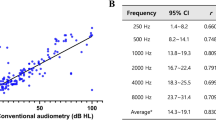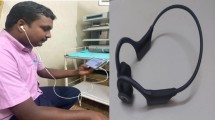Abstract
Hearing loss is widespread among the elderly. One of the main obstacles to rehabilitation is identifying individuals with potentially correctable hearing loss. Smartphone-based hearing tests can be administered at home, thus greatly facilitating access to screening. This study evaluates the use of a smartphone application as a screening tool for hearing loss in individuals aged ≥65 years. Twenty-six subjects aged 84.4 ± 6.73 years (mean ± SD) were recruited. Pure-tone audiometry was administered by both a smartphone application (uHear for iPhone, v1.0 Unitron, Canada) and a standard portable audiometer by trained personnel. Participants also completed a questionnaire on their hearing. Pure-tone thresholds were compared between the two testing modalities and correlated with the questionnaire results. The cutoff point for failing screening tests was a pure tone average of 40 dB for the frequencies 250–6,000 Hz. The smartphone application’s pure tone thresholds were higher (poorer hearing) than the audiometric thresholds, with a significant difference in all frequencies but 2,000 Hz. The application and the audiometric values were in agreement for 24 subjects (92 %). The application had a sensitivity of 100 % and specificity of 60 % for screening compared with the audiometer. The questionnaire was significantly less accurate, having assigned a passing score to three participants who failed both the application and audiometric tests. While a smartphone application may not be able to accurately determine the level of hearing impairment, it is useful as a highly accessible portable audiometer substitute for screening for hearing loss in elderly populations.

Similar content being viewed by others
References
Agrawal Y, Platz EA, Niparko JK (2008) Prevalence of hearing loss and differences by demographic characteristics among US adults: data from the National Health and Nutrition Examination Survey 1999–2004. Arch Intern Med 168(14):1522–1530
Mościcki EK, Elkins EF, Baum HM, McNamara PM (1985) Hearing loss in the elderly: an epidemiologic study of the Framingham Heart Study Cohort. Ear Hear 6:184–190
Gates GA, Cooper JC Jr, Kannel WB, Miller NJ (1990) Hearing in the elderly: the Framingham cohort, 1983–1985. Part I. Basic audiometric test results. Ear Hear 11(4):247–256
Cruickshanks KJ, Wiley TL, Tweed TS et al (1998) Prevalence of hearing loss in older adults in Beaver Dam, Wisconsin. The epidemiology of hearing loss study. Am J Epidemiol 148(9):879–886
Sataloff RT (2012) Hearing loss: economic impact. Ear Nose Throat J 91(1):10–12
Kim HN, Kim SG, Lee HK et al (2000) Incidence of presbycusis of Korean population in Seoul, Kyunggi and Kangwon provinces. J Korean Med Sci 15:580–584
Jennings CR, Jones MD (2001) Presbyacusis [review]. J Laryngol Otol 115:171–178
Lin FR (2011) Hearing loss and cognition among older adults in the United States. J Gerontol A Biol Sci Med Sci 66(10):1131–1136
Gopinath B, Schneider J, McMahon CM, Teber E, Leeder SR, Mitchell P (2012) Severity of age-related hearing loss is associated with impaired activities of daily living. Age Ageing 41:195–200
Mulrow CD, Aguilar C, Endicott JE et al (1990) Quality-of-life changes and hearing impairment. Ann Intern Med 113:188–194
Hasson D, Theorell T, Wallén MB, Leineweber C, Canlon B (2011) Stress and prevalence of hearing problems in the Swedish working population. BMC Public Health 11:130
Jung D, Bhattacharyya N (2012) Association of hearing loss with decreased employment and income among adults in the United States. Ann Otol Rhinol Laryngol 121(12):771–775
Yueh B, Shapiro N, MacLean CH, Shekelle PG (2003) Screening and management of adult hearing loss in primary care: scientific review. JAMA 289:1976–1985
Mulrow CD, Tuley MR, Aguilar C (1992) Sustained benefits of hearing aids. J Speech Hear Res 35:1402–1405
Jerger J, Chmiel R, Florin E, Pirozzolo F, Wilson N (1996) Comparison of conventional amplification and an assistive listening device in elderly persons. Ear Hear 17:490–504
Yueh B, Souza PE, McDowell JA et al (2001) Randomized trial of amplification strategies. Arch Otolaryngol Hear Neck Surg 127:1197–1204
Popelka MM, Cruickshanks KJ, Wiley TL, Tweed TS, Klein BE, Klein R (1998) Low prevalence of hearing aid use among older adults with hearing loss: the Epidemiology of Hearing Loss Study. J Am Geriatr Soc 46:1075–1078
Chang HP, Ho CY, Chou P (2009) The factors associated with a self-perceived hearing handicap in elderly people with hearing impairment—results from a community-based study. Ear Hear 30(5):576–583
Wiley TL, Cruickshanks KJ, Nondahl DM, Tweed TS (2000) Self-reported hearing handicap and audiometric measures in older adults. J Am Acad Audiol 11:67–75
Hannula S, Bloigu R, Majamaa K, Sorri M, Mäki-Torkko E (2011) Self-reported hearing problems among older adults: prevalence and comparison to measured hearing impairment. J Am Acad Audiol 22(8):550–559
Yueh B, Collins MP, Souza PE et al (2010) Long-term effectiveness of screening for hearing loss: the screening for auditory impairment–which hearing assessment test (SAI-WHAT) randomized trial. J Am Geriatr Soc 58(3):427–434
Handzel O, Ben-Ari O, Damian D, Priel MM, Cohen J, Himmelfarb M (2013) Smartphone-based hearing test as an aid in the initial evaluation of unilateral sudden sensorineural hearing loss. Audiol Neurotol 18:201–207
Folstein MF, Folstein SE, McHughP PR (1975) “Mini-mental state”. A practical method for grading the cognitive state of patients for the clinician. J Psychiatr Res 12(3):189–198
Szudek J, Ostevik A, Dziegielewski P et al (2012) Can uHear me now? Validation of an iPod-based hearing loss screening test. J Otolaryngol Head Neck Surg 41(1):S78–S84
Hidalgo JL, Gras CB, Lapeira JM et al (2008) The Hearing-Dependent Daily Activities Scale to evaluate impact of hearing loss in older people. Ann Fam Med 6(5):441–447
American Speech-Language Hearing Association. Degree of hearing loss. http://www.asha.org/public/hearing/Degree-of-Hearing-Loss. Accessed 19 Feb 2014
Christensen K, Doblhammer G, Rau R, Vaupel JW (2009) Ageing populations: the challenges ahead. Lancet 374:1196–1208
Lutz W, Sanderson W, Scherbov S (2008) The coming acceleration of global population aging. Nature 451:716–719
Kochkin S (1997) MarkeTrak IV: what is the viable market for hearing aids? Hear Jour 50(1):31–38
Moyer VA (2012) Screening for hearing loss in older adults: US Preventive Services Task Force Recommendation Statement. Ann Intern Med 157(9):655–661
Ventry IM, Weinstein BE (1983) Identification of elderly people with hearing problems. ASHA 25:37–42
Lichtenstein MJ, Bess FH, Logan SA (1988) Diagnostic performance of the hearing handicap inventory for the elderly (screening version) against differing definitions of hearing loss. Ear Hear 9(4):208–211
Czaja SJ, Charness N, Fisk AD et al (2006) Factors predicting the use of technology: findings from the Center for Research and Education on Aging and Technology Enhancement (CREATE). Psychol Aging 21(2):333–352
Umemuro H (2004) Computer attitudes, cognitive abilities, and technology usage among older Japanese adults. Gerontechnology 3:64–76
Sherwin-Smith J, Pritchard-Jones R (2012) Medical applications: the future of regulation. Ann R Coll Surg Engl 94:12–13
Acknowledgments
Esther Eshkol, the institutional medical and scientific copyeditor, is thanked for editorial assistance.
Conflict of interest
None.
Author information
Authors and Affiliations
Corresponding author
Additional information
S. Abu-Ghanem and O. Handzel contributed equally.
Rights and permissions
About this article
Cite this article
Abu-Ghanem, S., Handzel, O., Ness, L. et al. Smartphone-based audiometric test for screening hearing loss in the elderly. Eur Arch Otorhinolaryngol 273, 333–339 (2016). https://doi.org/10.1007/s00405-015-3533-9
Received:
Accepted:
Published:
Issue Date:
DOI: https://doi.org/10.1007/s00405-015-3533-9




